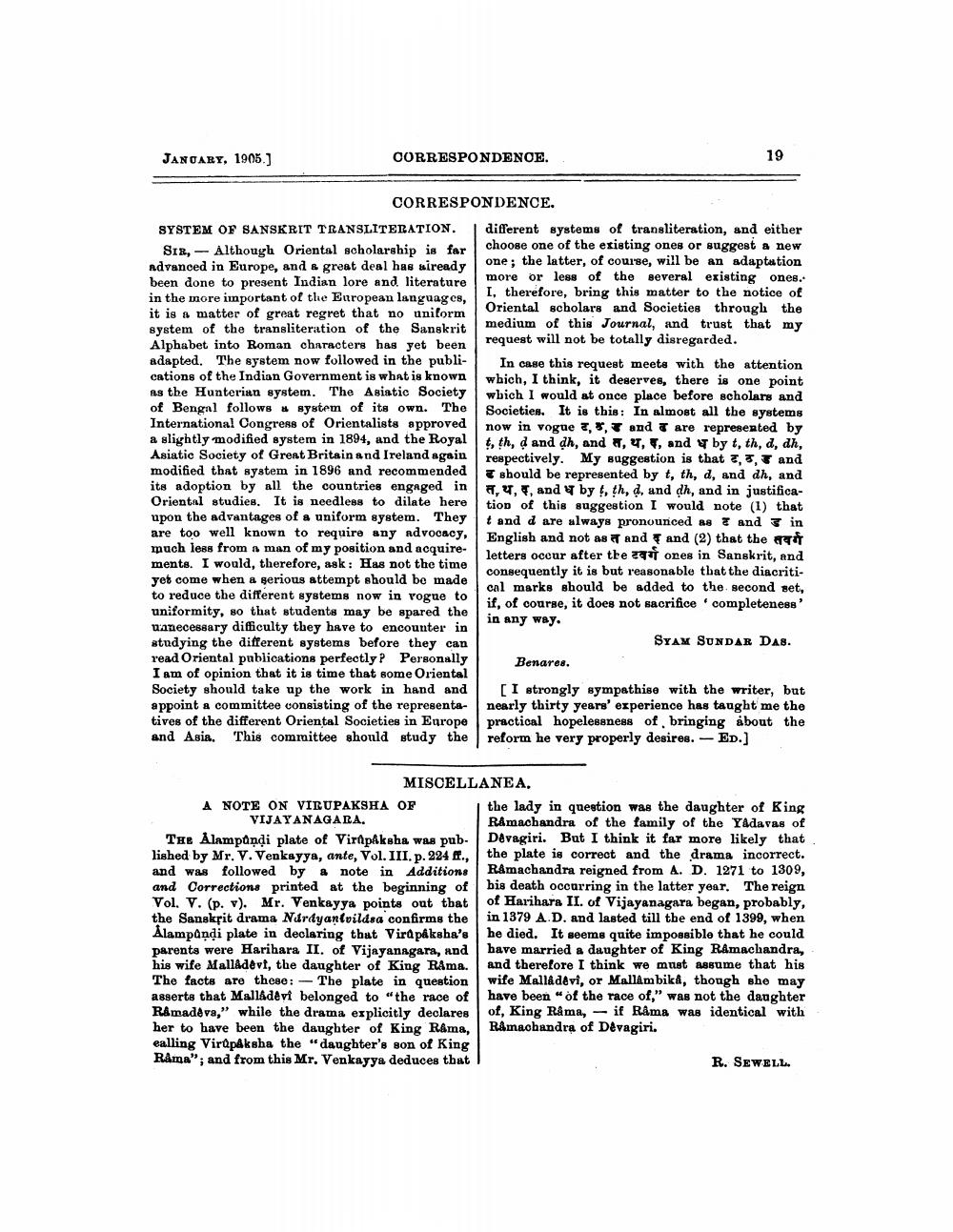________________
JANUARY, 1905.)
CORRESPONDENCE.
CORRESPONDENCE. SYSTEM OF SANSKRIT TRANSLITERATION. | different systems of transliteration, and either SIR, - Although Oriental scholarship is far
choose one of the existing ones or suggest a new advanced in Europe, and a great deal has aiready
one; the latter, of course, will be an adaptation been done to present Indian lore and literature
more or less of the several existing ones.. in the more important of the European languages,
I, therefore, bring this matter to the notice of it is a matter of great regret that no uniform
Oriental scholars and Societies through the system of the transliteration of the Sanskrit
medium of this Journal, and trust that my Alphabet into Roman characters has yet been
request will not be totally disregarded. adapted. The system now followed in the publi- In case this request meets with the attention cations of the Indian Government is what is known which, I think, it deserves, there is one point As the Hunterian system. The Asiatic Society wbich I would at once place before scholars and of Bengal follows # system of its own. The Societies. It is this: In almost all the systems International Congress of Orientalists approved now in vogue , %, and are represented by
slightly modified system in 1894, and the Royalt, th, d and dh, and , , , and by t, th, d, dh, Asiatic Society of Great Britain and Ireland again
respectively. My suggestion is that 7, 3, 7 and modified that system in 1896 and recommended should be represented by t, th, d, and dh, and its adoption by all the countries engaged in ... and by 1, th, d, und dh, and in justificaOriental studies. It is needless to dilate heretion of this suggestion I would note (1) that upon the advantages of a uniform system. They lt and d are alwave pronounced BA and are too well known to require any advocacy,
English and not as and and (2) that there much less from a man of my position and acquire
letters occur after the ones in Sanskrit, and mente. I would, therefore, ask: Has not the time
consequently it is but reasonable that the diacritiyet come when a serious attempt should be made
cal marks should be added to the second set, to reduce the different systems now in vogue to
if, of course, it does not sacrifice completeness' uniformity, 80 that students may be spared the
in any way. wanecessary difficulty they have to encounter in studying the different systems before they can
SYAM SUNDAR DAS. read Oriental publications perfectly? Personally
Benares. I am of opinion that it is time that some Oriental Society should take up the work in hand and [I strongly sympathise with the writer, but appoint a committee consisting of the representa- nearly thirty years' experience has taught me the tives of the different Oriental Societies in Europe practical hopelessness of bringing about the and Asia. This committee should study the reform he very properly desires. -Ed.]
MISCELLANEA, A NOTE ON VIRUPAKSHA OF
the lady in question was the daughter of King VIJAYANAGARA.
Råmachandra of the family of the Yadavas of The Alampandi plate of VirapAksha was pub- Devagiri. But I think it far more likely that lished by Mr. V. Venkayya, ante, Vol. III. p. 224 ff., the plate is correct and the drama incorrect. and was followed by a note in Additions Ramachandra reigned from A. D. 1271 to 1309, and Corrections printed at the beginning of bis death occurring in the latter year. The reign Vol. V. (p. v). Mr. Venkayya points out that of Harihara II. of Vijayanagara began, probably, the Sanskrit drama Nerdyantvildsa confirms the in 1379 A.D. and lasted till the end of 1399, when Alampandi plate in declaring that Vird påksha's he died. It seems quite impossible that he could parents were Harihara II. of Vijayanagara, and have married a daughter of King Ramachandra, his wife MallAdévf, the daughter of King Råma. and therefore I think we must assume that his The facts are these: - The plate in question wife Malladevi, or Mallámbika, though she may asserts that Malladevt belonged to "the race of have been " of the race of," was not the daughter Ramadeva," while the drama explicitly declares of, King Råma, - if Råma was identical with her to have been the daughter of King R&ma, Ramachandra of Devagiri. ealling Virūpåksha the "daughter's son of King Rama"; and from this Mr. Venkayya deduces that
R. SEWELL.




